What’s THAT thing? A question we’re often asked when anchoring. This year we were even told that we must be the last cruisers in history that actually use such a device. But we’re believers and David’s even gotten in the water in Belize during a blustery cold front when it’s blowing 30 to watch what happens with the anchors, chain and our kellet.
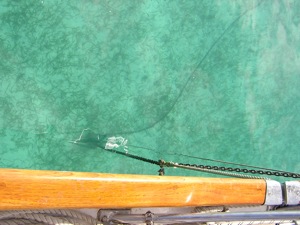
The first thing he noticed is that with the biggest gusts, the force would lift the kellet up several feet – normally, it’s supposed to be deployed on the chain a few feet above the bottom. He also noticed that from the anchor up, the chain stayed flat on the botttom. There was no pull on the anchor whatsoever. In conditions when the water is really rough or the wind is veering or clocking, there’s still little pull on the chain, only the “fan” marks in the sand behind the anchor where the chain moved accommodating the swing of the boat. And despite the fact that we back the boat down hard before we finalize the anchor & put the kellet in place, often the chain is curved all over the place down below.
Here’s what David observed when he was below watching the kellet. This illustration is from the Kiwi Anchor Buddy website, click here. The kellet we use is a Kiwi Anchor Buddy, but other boats have systems made from dive weights or similar homemade versions. The “buddywarp” in the illustration is the little line that’s attached to the kellet to lower it down the chain or raise it when we’re ready to leave.
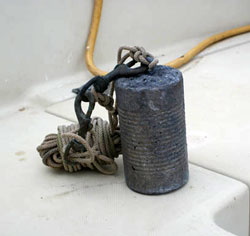
Our kellet does not “help the anchor dig in” because we back it down until it’s either completely buried or as “dug in” as possible BEFORE we put the kellet in place. In extreme windshift conditions, our Spade anchor resets itself very well on it’s own, but I’m sure the kellet taking alot of the pressure off the anchor helps it not need to reset nearly as often.
Here’s how Chapman’s describes a kellet or sentinel — a fancy name for an extra weight added to your anchor chain:
“A sentinel (kellet) is a weight typically around 25-30lb suspended from the rode to help keep the pull on the anchor as horizontally as possible to prevent dragging in rough weather”
Chapman’s “Piloting, Seamanship and Small Boat Handling”
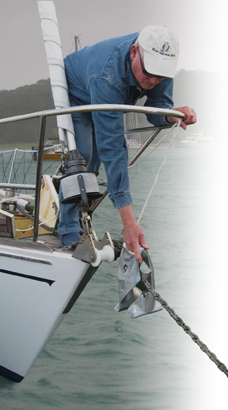
We don’t just use our kellet in bad weather. We decided that if the concept works for rough weather, it should help in ALL kinds of weather … and bottom conditions. David swears half the time we’re just anchored on the kellet – which weighs 30 lbs.
Another possible advantage might be to help the boat from dancing so much around the anchorage. Although definitely not a scientific claim, we’ve noticed that our boat seems to swing much less than other boats in an anchorage. David thinks it’s because the kellet helps hold us in place with a dampening effect. Who knows. All we know is we like it & we’ll continue to be “the last cruisers in history who use such a device”.
What about you? Do you regularly use a kellet? Or do you reserve using it for when you have a storm brewing? Please leave a comment and share your thoughts!
Cheers! Jan & David
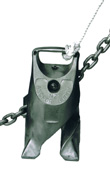
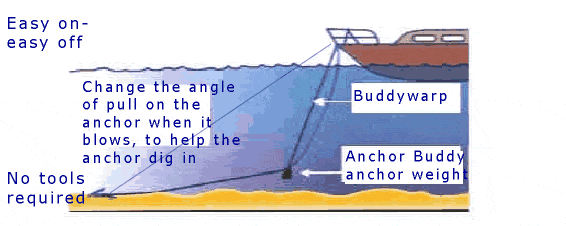












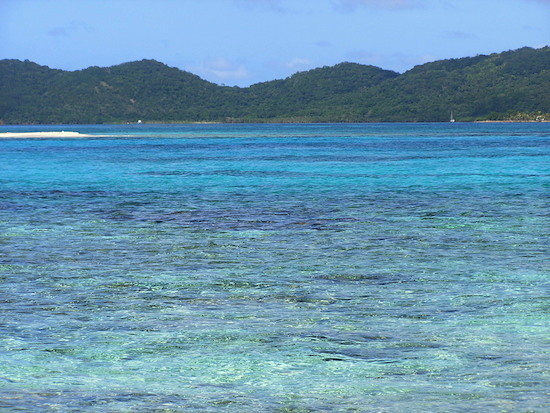
Great information for someone like myself who is still learning. This is definitely something I will look for.
On my previous boat an (Alberg 30 with nylon rode) I bent on 10ft of 3/4″ chain about 40 ft from the anchor that acted like a sentinel. This was light enough to allow me to set the anchor as you do but is heavy enough to reduce swing in calm conditions. If the wind rose during the night (it’s always at night) it would lift and let the boat move.
John
I have used a 15 lb mushroom anchor as a sentinel for many years. We sail on the Mississippi, and if the breeze is upstream and the current down, our 37 Endeavour wanders enough overnight to wrap the 2 strand nylon anchor rode around our keel! The sentinel keeps the rode below the keel, which is even more important to me than increasing holding power!
Nice, thanks everyone, I gotta start building one myself, now.
s/v Renasci
[…] pointing 'into' the wind for less developed strain, and shock load' on the anchoring system.. ** What?s a Kellet? Anchor Insurance! […]
This is a great description of a technique I was unfamiliar with on improved anchoring. I always use a snubber to reduce shock loads on my electric windless on our Jeanneau SO 36i, so my question is: Does a kellet eliminate the need for a snubber? It seems so, and using both may seem like overkill in most situations, but any opinion would be appreciated.
Craig
Hi Craig! Totally different functions. Our kellet was free to “float” up and down the anchor chain as needed. The line was only to allow the kellet to run up and down while remaining attached. The snubber takes the strain from the chain to the windlass, so, no the kellet does not eliminate the need for a snubber. Cheers! Jan